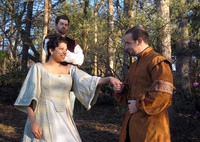Shakespeare in the Arb's 'The Winter's Tale' offers moments of beauty, among the bugs

Leontes (Graham Atkin) is suspicious of his wife, Hermione (Maria Thomas) and his best friend Polixenes (Sam Dodge) during a rehearsal for "The Winter's Tale."
It must be time once again for Shakespeare in the Arb’s annual production—this year, “The Winter’s Tale,” a play perhaps best known for possessing one of the most noteworthy stage directions in theater history: “Exit, pursued by a bear.”
Odd? Indeed. But then, so is the play, which mashes together elements of tragedy, comedy, and romance.
The story begins with Leontes, a king, asking his wife, Hermione, to persuade his longtime friend (and fellow king) Polixenes to extend his visit. When she succeeds, the king’s imagination runs wild with suspicion and jealousy, so that he orders Polixenes’ death—though the command is ultimately foiled by Polixenes’ escape—and puts Hermione in prison. While there, she gives birth to a daughter, which Leontes—after being talked out of killing the child—sends away to be abandoned in the wilderness. And when the Oracle pronounces Hermione’s innocence, Leontes rejects the report, only to immediately hear of his young son’s death from grief, which triggers the fainting, and consequent death, of Hermione. Leontes finally realizes his mistakes and vows to spend his life in mourning.
16 years later, we see Polixenes’ son, Florizel, wooing Perdita, a lowly shepherd’s daughter. Polixenes spies on the two at a sheep-shearing festival before revealing himself and raging against the match. Camillo, who formerly served Leontes and fled with Polixenes years earlier, longs to see his homeland again, so he suggests that Florizel and Perdita travel to Sicilia to be together. Once there, Perdita (and everyone else) learns of her true heritage, and a just-unveiled, life-like statue of Hermione proves to be the wronged queen herself.
The play has its maddening qualities—I can't help wanting to slap Leontes on the head repeatedly—and it’s initially tough to key into its rhythms. But once director Kate Mendeloff’s nearly three-hour “traveling” production (which is set in different parts of Nichols Arboretum) gets beyond its first series of scenes, clarity and creative staging work their magic.
Yes, the quality of the acting varies rather widely—the cast combines members of the community with students and U-M faculty members—but overall, the performers have a firm grasp on the language and, more importantly, the meaning of what they’re saying. (I struggled to hear certain actors at times, particularly in the early scenes, so I’d recommend sitting as close to the action as you can.)
Because the show has no programs, and the play is almost entirely double-cast for alternating performances, highlighting specific actors is a dicey venture. Yet I will say that for opening night’s performance, Maria Thomas’ Hermione provided a solid, sympathetic anchor for the first act, while audience favorite Roderick Jefferson’s hammy Autolycus later offered some much-appreciated lightness and comic relief.
As staged by Mendeloff, “Tale’ works well in its outdoor setting, and having a handful of live musicians (also in costume) playing between scenes, while the audience walks to the next locale, adds a nice touch. Such attention to detail is also apparent in the choreographed swordplay and dances, although the actors’ execution of both sometimes felt self-conscious on opening night.
Finally, regarding that bear—is that moment ever played “straight”? Is it possible to do so? Or is this famous exit forever destined to evoke laughs (as it did at the Arb)? In a way, the moment exemplifies the play’s central challenge (and, for some, its appeal). In trying to take on so many different tones and moods, “Tale” defies an audience’s attempts to plug in and feel “settled” within the world of the play.
There are, as always, potential drawbacks to experiencing theater outdoors. You should bring bug spray, or risk being eaten alive; the actors’ voices may be suddenly overwhelmed, at any given moment, by low-flying planes, train whistles, or strangely cacophonous birdsong; and weather conditions may change dramatically over the course of three hours, so bringing sunglasses, an umbrella, and a jacket is advisable. (Bringing a fold-up chair is also an option, for those who don’t want to sit on the ground or a blanket.)
Yet outdoor shows also, of course, nearly always feature moments of unexpected, unscripted beauty, which act as the payoff. On “Tale”’s opening night, for instance, as Perdita and Florizel plotted their escape to Sicilia, two low-flying birds soared out from the trees behind the actors and winged their way over the audience. And at various times, tufts of white fluff fluttered down from the trees onto the crowd, offering just the smallest visual hint, appropriately, of winter-gone-by.
These are things you wouldn’t normally experience while watching “The Winter’s Tale,” of course—which is probably why Shakespeare in the Arb has become such a popular annual tradition.
Jenn McKee is the entertainment digital journalist for AnnArbor.com. Reach her at jennmckee@annarbor.com or 734-623-2546, and follow her on Twitter @jennmckee.
Event details from AnnArbor.com calendar Preview article from AnnArbor.com

